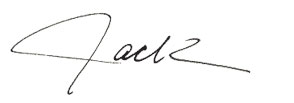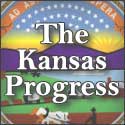The New New Deal?

Tune in for what's new in Kansas: It's a web-based news site, and regularly published journal, dedicated to limited government in the great state of Kansas. |
![]()
by Jack Cashill
Published in ingramsonline.com - November 2009
Students of History May recognize a few similarities between Barack Obama’s view of what America should be and Franklin Roosevelt’s. But beyond similarities, they should be paying attention to outcomes.
Those Kansas City business people whose fortunes hinge on the caprices of the current administration—Blue Cross Blue Shield comes to mind—might divine their future by delving into the past, specifically the past as served up by one Franklin Delano Roosevelt.
The parallels between FDR and BHO are hard to miss: the eagerness to improvise, the impulse to control, the urge to scapegoat, the willingness to let business wonder what fresh hell tomorrow might bring.
If there is any one image that evokes the whimsy of the original New Deal, it is this one: FDR sitting in his bedroom with Secretary of the Treasury Henry Morgenthau Jr., picking the daily price of gold.
Morgenthau would later tell of the day when FDR decided to set the gold price at 21 cents. “Why 21 cents?” asked Morgenthau. “It’s a lucky number,” the president remarked, “because it’s three times seven.” Say what you will, but the man knew his timetables!
Just five years earlier, America sat astride the economic world, the repository of most of its gold and even more of its hope. The president at that time, Republican Calvin Coolidge, could not have differed more from FDR.
Businesses, Coolidge believed, welcomed an administration whose approach to its business clientele mirrored Holiday Inn’s— “no surprises.” Businesses, Coolidge felt, could plan more confidently if they could trust their government not to jack with the law of the land.
“We are spending more money than we have ever spent before and it does not work.”
Henry Morgenthau Jr., 1939
As vice-president under Harding, Coolidge had seen how the White House’s hands-off approach to the sharp downturn of 1920 had allowed businesses to cut their losses, trim their payrolls and get back to work quickly. The years since had, by all accounts, been years of sustained and substantial growth.
As to the precipitating event that led to the crash of 1929, fingers point in a thousand directions, but a market crash does not necessarily lead to depression, even recession. Case in point: October 1987. That the depression of the 1930s merited a capital “D” and the curious descriptor “Great” is due in no small part to the two activist presidents who mismanaged it.
On the job when the market crashed, Herbert Hoover contributed his own fair share to the unraveling. “Words are not of any great importance in times of economic disturbance,” he announced. “It is action that counts.”
Unfortunately, just about every action Hoover took proved to be the wrong one. He raised taxes, browbeat businesses into sustaining wages and employment, bullied the stock market, and signed into law the flamingly disastrous Smoot-Hawley Tariff Act of 1930.
The improvisational Roosevelt made Hoover look like Coolidge. In his March 1933 inaugural address, Roosevelt may have eased the fears of the ordinary Joe, but he scared the hell out of guys with names like “Pierpont.”
“The rulers of the exchange of mankind’s goods,” he insisted, “have failed through their own stubbornness and their own incompetence.” From that day forward, no business person could anticipate FDR’s market logic du jour any better than he could his gold price.
After a few bromides, Roosevelt turned his inaugural sights on “the evils of the old order.” That this order had made America so dang prosperous that its dispossessed could drive their own Model-A’s to California was lost on Roosevelt and his allies.
“There must be a strict supervision of all banking and credits and investments,” FDR railed, fully ignoring the role of government in creating the mess at hand. “There must be an end to speculation with other people’s money, and there must be provision for an adequate but sound currency.”
Roosevelt proved to have unusual ideas as to what exactly constituted a “sound currency,” especially when it came to gold. Within a week of the inauguration, he used the legal cover of the wartime Trading With The Enemy Act to declare war on those who were “hoarding” gold and promised—yikes!—as much as 10 years in prison for those who failed to surrender all of it.
The civic strip mining of America’s gold was executed without benefit of a single congressional hearing. Needless to say, this process did not inspire a lot of confidence within the business community.
Roosevelt was just as adventurous on the banking front. Upon taking office, he had Congress pass the Emergency Banking Act, which gave him the power not only to close banks but also to print money wartime style as he saw fit.
“These economic royalists complain that we seek to overthrow the institutions of America,” he argued at his second inaugural. “What they really complain of is that we seek to take away their power.” Sound familiar?
From day one, Roosevelt had done his best to dethrone the “privileged princes of these new economic dynasties,” FDR-code for those bankers who had not failed their customers.
In fact, it was the major investment banks like the House of Morgan that had been diversified enough to protect their depositors.
Royalism did not cause the great majority of bank failures. Regulation did. Some 90 percent of failures occurred in states whose “unit” banking laws forbade banks from branching out beyond their base. Canada, which had no such laws, had no such problems.
In June 1933, Roosevelt signed into law the Glass-Steagall Act. Banks now had to choose between investment and deposit banking. They could not do both.
A classic in political scapegoating, the act rewarded those banks that had done the worst and punished the banks that had done the best. It provided deposit insurance for the struggling banks and forced the successful ones to divest their investment banking operations.
In 1935, forced to choose between deposit banking and investment banking, the House of Morgan shocked Wall Street by abandoning the side of the business that had made it rich and famous. With the investor class paralyzed by uncertainty, commercial banking remained its bread and butter.
For all of the sound and fury of FDR’s reign, and for all the soothing charm of his style, the New Deal did not deliver. And no one knew that better than a seriously bummed Morgenthau.
“We are spending more money than we have ever spent before and it does not work,” he told a congressional hearing in 1939.
“I want to see this country prosperous. I want to see people get jobs. We have never made good on our promises. I say after eight years of this administration, we have just as much unemployment as when we started and an enormous debt to boot.”
In 1939, the number 17—as in a 17 percent unemployment rate—was no one’s idea of a lucky number. In 2009, alas, we’re working our way up.


